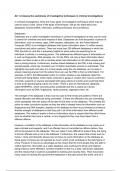AC 1.2 Assess the usefulness of investigative techniques in criminal investigations
In criminal investigations, there are many types of investigative techniques which may be
used to solve a case. Some of the types of techniques I will go into detail about are:
databases, forensics/DNA, interviews, profiling techniques and surveillance.
Databases
Databases are a useful investigative technique in criminal investigations as they can be used
to search for criminals and store masses of data. Databases can hold thousands of pieces of
information, such as names, ages, DNA samples, addresses, etc. the Police National
Computer (PNC) is an intelligent database that stores information about 12 million arrests,
convictions and police cautions. There are more than 200 different databases in which the
PNC has links to, and this is extremely helpful for when police are searching for an
individual, a vehicle or a missing person. The database has different types of information on
it, such as fingerprints, SNA samples, etc. On the PNG, not only is there information about
people, but there is also a link to vehicles which has information on 48 million people who
have a driving licence. Furthermore, another linked database to the PNC is the missing and
wanted people, which has recorded over 3.5 billion searchable records on individuals. This
highlights how quick and easy it is to find people using the one database, as it is easy to
access meaning anyone from the police force can use the PNC to find out information. For
example, in 2012, the Metropolitan police in London created a new database called the
Crimint and Gang Matrix, which tracks criminals in gangs in London who may be confirmed
criminals, suspects or anyone associated with gang culture of London,and could help them
to look at the general gang culture of London. There is also an international; database,
called INTERPOL, which connects police worldwide and this is useful as it shows
information such as DNA, fingerprints, stolen property, organised crime, etc
The strength of the database is that it can be used to find trends and patterns if there are
repeat offenders and offences being committed., If there are offenders who are committing
crime repeatedly, then the police will be able to find them on the database. This enables the
police to make convictions quicker as they are able to already have the information such as
fingerprints and DNA samples, already on the database for them to put forward as evidence.
Another strength of databases is that they pull in all of the information from different small
databases. This makes it easier to find out information about a suspect that they didn't know,
such as whether they have a vehicle, or any fingerprints they may have taken from a
different offence.
However, a limitation of the database is that information of the database is only made up of
past criminals and suspects, and if an offender has not committed an offence before, they
will not be present on the database, This can make it more difficult for police if they are trying
to find an offender who is not in the database. Furthermore, this means that crimes such as
honour crime and domestic abuse may not have as much information on the database as
these types of crimes are not reported as much, which could contribute to the dark figure of
crime. However it may be an advantage as this means that the more people they are able to
collect data from, this builds up a wider database, and could lead to family and relatives
being linked to some offenders. Another limitation is that it is a wide, well-known database,
and this means that it could be susceptible to hacking and security risks. There have been
many cases of hacking into government databases in the past around the world, and so if
, the PNC was to be hacked, this could be a huge breach of data. Another limitation is that it
could be used wrongly by some officers if they have wrong intentions, For example, an
officer who has certain racial biases may purposefully try to look for patterns of data in
certain races to try to convict a certain person due to prejustices
DNA
DNA is a technique used in criminal investigations which can help police identify someone
based on their DNA. It was first developed by Alec Jefferys in 1985. In almost all of the cells
of the body, DNA can be found, and all DNA is unique to a person, unless someone has an
identical twine. Recently, this criminal investigative technique has been developed over the
years and has been useful for the extraction and analysis of DNA in high quantities., which
has proven very helpful in solving past and current cases. As a result, DNA profiling has
become the most important development in forensic investigation, ever since fingerprinting
was invented. Police are able to take two types of DNA samples: intimate and non-intimate.
Intimate samples are taken with a person's consent, and they may require samples of
semen, blood, etc. Non intimate samples do not need a person's consent to be taken, and
some samples could include mouth swabs, tongue swabs, etc. It is important for a person
organising the sample. Such as a police officer or a SOCOO to make sure that yenDNA is
packaged and stored properly to ensure that there is no contamination of the DNA.
A strength of using DNA forensics in criminal investigations is that the DNA is unique to
everyone, and no one has the same DNA, making convictions more precise and easier.
Another strength is that it can help identify an individual if there are no other ways of
identifying them. Making it easier to identify victims and offenders. Another strength is that
DNA can be used to trace back to family members and relatives, meaning that it can be
easier to track down someone's family history if it is needed. A case in which this was used
was the case of Collete Aram, who was murdered in 1983, prior to forensics being
discovered. Once DNA forensics were discovered, police were able to establish the
database and collect the samples from the general public and criminals. Paul Hutchinson
was able to be convicted for the murder when a close family member had their DNA taken
for a driving offence. Even though Paul Hutchinson's DNA had not been on the database,
this close relative’s DNA was able to convict him due to similarities from DNA.
Another strength is that it gives us the chance to solve past cases that may not have had
DNA forensics available, meaning that past cases can be solved and offenders can be
convicted. An example of a case where DNA forensics has been used is the case of Colin
Pitchfork. He was the first person to be convicted of a crime using DNA evidence. He was
convicted of the rape and murder of 2 girls in 1983 and 1986. Semen samples were taken
from the victims and then blood samples were taken amongst 4,000 men in his community,
ultimately leading to Colin Pitchforks arrest and conviction
However, a limitation of DNA is the fact that it could falsely imply a person is guilty of a crime
they have not committed, causing a miscarriage of justice. A case in which this happened
was the case of David Butler. He was a taxi driver who had a skin condition that caused his
skin to be more susceptible to flaking off. He was charged with the murder of a prostitute due
to the fact that there was a partial match to his DNA present on the victim. Being a taxi
driver, this meant that many people entered hgis taxi, and his DNA had been transferred
onto a passenger and then transferred onto the victim. He was put into custody for 8 months,







